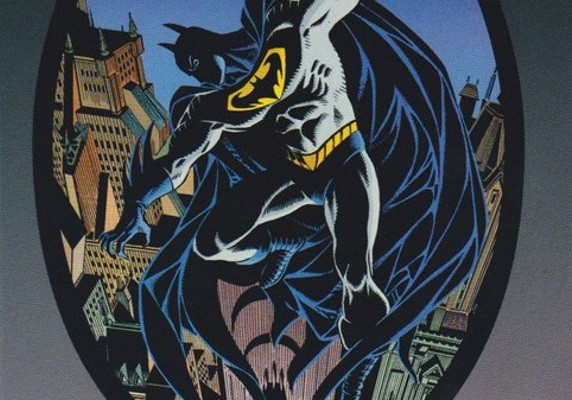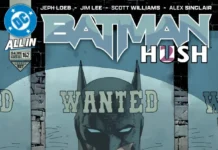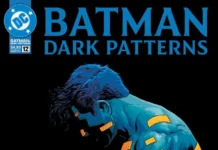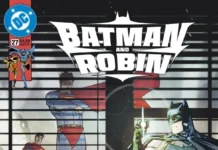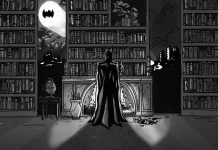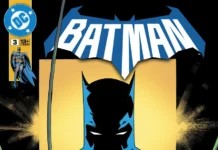EDITOR’S NOTE: CLICK HERE for all of BOF’s Batman ELSEWORLDS reviews/retrospectives.
Over the decades, comics’ two biggest stars have stayed closely linked and connected to one another.
They’ve been teammates, best friends, romantic rivals, bitter enemies, and temporarily assumed each other’s identities.
What hadn’t been seen however was a story in which Batman and Superman existed as one entity, a single character brought about from some twist in fate.
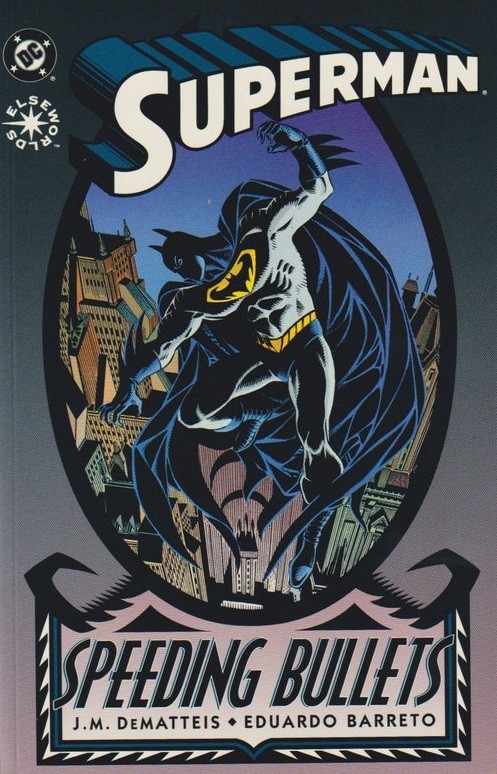 Published by DC Comics as a Prestige Format one-shot in 1993 under the ELSEWORLDS banner, Superman: Speeding Bullets was written by J.M. DeMatteis and drawn by Eduardo Barreto. While the book’s title clearly positioned the book as a Superman story, the cover art showed a very familiar, if more masked, Batman looking down on the gothic cityscape of Gotham. While the visage is clearly Bats, it is Kal-El beneath the cowl. Still, given the way the story plays out, it’s hard to argue that this is more of a Batman or Superman story.
Published by DC Comics as a Prestige Format one-shot in 1993 under the ELSEWORLDS banner, Superman: Speeding Bullets was written by J.M. DeMatteis and drawn by Eduardo Barreto. While the book’s title clearly positioned the book as a Superman story, the cover art showed a very familiar, if more masked, Batman looking down on the gothic cityscape of Gotham. While the visage is clearly Bats, it is Kal-El beneath the cowl. Still, given the way the story plays out, it’s hard to argue that this is more of a Batman or Superman story.
The book opens with an unknown narrator admitting that they have thought about all the different possibilities that could have taken place on the night that Kal-El’s space ship landed on Earth, affecting history by changing the fate of the orphaned alien child that grew to be Superman. The narrator decides there is only one what that it could have happened after all and, in this world, it means the Kryptonian baby landed in not in front of a kindly farm couple but in front billionaire industrialists Thomas and Martha Wayne.
This story unfolds fairly in line with to the Batman mythos with which we are accustomed, with a few key changes. The Waynes become very reclusive following their adoption of Kal-El/Bruce. They seldom make it into the city, apart from family trips to the cinema and this serves as the mechanism to get to the Wayne’s murder at the hands of Joe Chill.
However, in this reality young Bruce loses control of his yet to be discovered abilities and lashes out in rage and grief, killing Chill with his heat vision. The events prove too traumatic for Bruce and he represses the memories of the incident and his powers, going into seclusion until adulthood.
It’s interesting that the writer J.M. DeMatteis made the choice to keep this Bruce in isolation until manhood. While the standard continuity Bruce needed to go on a multi-year voyage to develop and perfect his skills, a Kryptonian would conceivably have no need to. The physical perfection is built in, as is the superior intellect, therefore what else is there to for this Bruce to do but brood (which he does in a stunning homage to the original Detective Comics origin imagery.)
 DeMatteis handles the book as smartly as anyone could imagine. Given the gimmicky nature of the story, it would be quite easy to stay on the surface, but DeMatteis unravels the psyche of Kal/Bruce. Crime finds its way into Wayne Manor when home intruders break in seemingly trying to rob the mansion. The event wakens Bruce’s memories and abilities with him easily dispatching the criminals. It is then the knowledge of these powers and the resulting guilt from knowing they could have been used to prevent his parent’s death that fuels his fight.
DeMatteis handles the book as smartly as anyone could imagine. Given the gimmicky nature of the story, it would be quite easy to stay on the surface, but DeMatteis unravels the psyche of Kal/Bruce. Crime finds its way into Wayne Manor when home intruders break in seemingly trying to rob the mansion. The event wakens Bruce’s memories and abilities with him easily dispatching the criminals. It is then the knowledge of these powers and the resulting guilt from knowing they could have been used to prevent his parent’s death that fuels his fight.
The result is a Batman that wages a slightly more vicious war on crime but still does not kill criminals. This Batman is not just looking for vengeance (he already killed his parents’ murderer) and is not only protecting the innocent; he is exorcizing his rage, anger, and guilt on the criminals of Gotham.
Bruce also leaves his self-sentenced seclusion, returning to an active role at Wayne Enterprises, a decision that angers both his board and Lex Luthor who has relocated to Gotham to take over the lead management of Bruce’s company. Luthor had previously been seriously injured in a chemical fire a year earlier and Wayne Enterprises was to serve as a sort of resurrection of his as a prominent socialite and businessman.
Bruce purchases the Gotham Gazette and goes about hiring an all-star team of employees including Perry White and Lois Lane who had been fired from the Daily Planet following its acquisition by Luthor.
The story that unfolds is a really a combined telling of Superman and Batman’s history, as well their key supporting figures and arch nemeses. We learn that the narrator is actually Lois, that Luthor and The Joker share more than a flair to elaborate evil plans, and why, with as much Batman as there is in this story, it still makes sense to have “Superman” in the title.
 While overall successful, there are a few week points in the storytelling. The dynamic between Luthor and The Joker is something many readers will predict early in the story, and the way that it unfolds feels a bit cartoony and over the top when compared much of the rest of the book. The turn in Kal-El/Bruce’s identity (and mental health) feels a bit rushed at the stories conclusion even though the payoff is thoroughly enjoyable.
While overall successful, there are a few week points in the storytelling. The dynamic between Luthor and The Joker is something many readers will predict early in the story, and the way that it unfolds feels a bit cartoony and over the top when compared much of the rest of the book. The turn in Kal-El/Bruce’s identity (and mental health) feels a bit rushed at the stories conclusion even though the payoff is thoroughly enjoyable.
The artwork by Barreto is solid and fits neatly into DC’s house style of the era with some strong similarity to Jerry Ordway’s pencils. Barreto is most effective in the books more noir moments with a strong handle of shadows and textures. Some of the more elaborate and colorful panels don’t fare as well, but as still serviceable. There appear to be some nods to the comic adaption of the 1989 Batman movie throughout, especially in the scenes with “The Joker.”
Overall, Superman: Speeding Bullets is a classic ELSEWORLDS tale combining DC’s two flagship characters. It is an enjoyable read with strong character work and good art that stumbles a bit in the “big” moments. It’s recommended reading for fans of either character, particularly those that have always struggled to decide which is their “number one guy.” – Garret Grev

